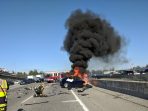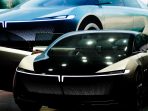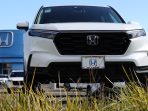Passengers ride in an electric Waymo full self-driving technology in Santa Monica
Allen J. Schaben | Los Angeles Times | Getty Images
Waymo, Alphabet‘s self-driving car unit, is having a relatively good couple of months – at least, compared to one of its key rivals: GM‘s Cruise.
Formerly known as the Google self-driving car project and now an independent subsidiary of Google parent-company Alphabet, Waymo has been operating in some capacity since 2009. Five years ago, the company launched what it billed as the “world’s first commercial autonomous ride-hailing service” in the metro Phoenix area, then last year expanded to San Francisco. The company soon plans to launch commercially in Austin, its fourth city, and also recently began test-driving vehicles in the winter weather of Buffalo, New York.
For much of this time, Cruise has seemed to be competing neck-and-neck: When Waymo raised funding at a $30 billion valuation in 2020, Cruise followed in 2021 with the same valuation. When Cruise began offering fully autonomous rides in San Francisco in the winter of 2022, Waymo followed in the fall. In August, California regulators voted to approve round-the-clock robotaxi service in San Francisco from both companies, making it the first major U.S. city to allow two robotaxi companies to compete for service “at all hours of day or night.”
Now, after a barrage of safety concerns and incidents with Cruise self-driving cars in recent months, the landscape looks starkly different. Cruise has paused all public road operations – both supervised and manual, laid off contractors and recalled nearly 1,000 robotaxis after a pedestrian collision. In October, the California Department of Motor Vehicles suspended Cruise’s deployment and testing permits for its autonomous vehicles, effective immediately, and last week, GM announced it would significantly cut spending on Cruise in 2024.
Amid the news, Waymo’s chief product officer, Saswat Panigrahi, told CNBC that the self-driving car unit hasn’t seen a change in tone from regulators or a shift in the company’s public perception.
Obviously, Waymo seems to be performing better than some competitors. What, exactly, do you think you’ve been doing differently?
There are no shortcuts. I mean, this is not a question you’re asking an app or a web page, which is giving you an answer. This is a multi-thousand pound vehicle that’s moving through the physical world – yes, it’s an application of AI but a very different kind of application of AI. And there’s something to be said about time and experience and just rigor that no matter how hard you work, it takes time to do this.
So I would say that the amount of data you’ve tested yourself against – you could always test more, but the staggering scale of testing that has been brought to bear – I sometimes say that building the Waymo Driver is a hard thing, but it’s almost as hard to evaluate the Driver. The amount of simulation we have had to do… has taken a decade. It took Google’s level of infrastructure because even to simulate at that scale, as you and I are speaking right now, 25,000 vehicles in our simulator are learning to drive better. To bring that, you need incredible infrastructure capability because even if you had the AI capability, without the infrastructure, it’d be very hard to bring that skill to bear – a decade of investment into AI before AI was cool.
Compute infrastructure, to power those simulations?
Yeah, some of it is just raw scale of compute, how many computers can you bring to bear, that kind of thing. But some of it is also – think of the old-school video game versus how realistic video games have become now, that’s a metaphor for how things are. Let’s say we saw a person in Phoenix speeding at 60 miles an hour on a 45 mile-per-hour [street], and then imagine that we saw a very tight intersection in SF – can you realistically mix these two to challenge your driver to a harsher situation that may occur many millions of miles later in the real world?
[On top of that], being able to add rain, for example – all right, you’re safe enough when you’re driving through good weather, through this tight intersection with a speeding agent. Can you do that as well in rain? Can you do that at night? You can’t wait for the rain in real life to occur exactly when you want to push your system in that way, but being able to simulate rain requires that infrastructure but also enough algorithms and realism on top to be able to push this.
Can you get specific about how much compute that requires?
I have worked with pretty high-scale systems before Waymo, at Google and Ericsson, and this is a pretty staggering scale. But the only number I can tell you is 25,000-plus virtual vehicles driving continuously, 24/7, learning from each other, and [tens of] billions of miles in simulations. Think of how much you or I drive in a year – we drive, what, 10,000 miles in any given year…? Now think of billions of miles of experience – close to seven orders of magnitude difference.
Let’s talk about the shift in ridership over the past month. Have you seen an increase? Decrease?
Things are growing – to give you an idea, this year we have more than 10x’d [trips with public riders]… The ridership is increasing in both Phoenix and SF. We are well ahead of 10,000 trips [in each city] every single week… So it’s going well. We’re taking the time to respond to feedback and thoughtfully expand.
[Note: Waymo recently shared that Waymo riders took more than 700,000 trips in autonomous vehicles in 2023.]
Amid all the controversies, in recent months, what’s been the impact on public perception of your programs?
For riders, it’s just been an incredibly positive response. We look at their ratings, we look at their usage patterns, we look at what they qualitatively tell us, we speak to them in focus groups and all of them have been overwhelmingly positive…
On people we share the city with – communities, groups, like first responders, firefighters and so on – we’re continuously engaged with them. We’re listening to their feedback. We have trained more than 5,000 first responders in SF alone, multiple training sessions, and based on that have [brought] new features. For example, now we can signal intensities to firefighters that, “Hey, we’re about to make a U-turn and get out of this scene.”
Over the same period, have regulators’ demands of the Waymo team changed at all?
With regulators, we have a very open dialogue and submitted more data than they ever asked for… So it has been a very positive engagement with them, but no change in tone.
We were the first company that openly released our safety framework, the mechanism by which we test the performance of our system and how we determine when we’re ready to deploy, three years ago. We were also the first to release all of our collision data from the fully autonomous service… Those were all before any regulator asked us for something. And then yes, we do submit ongoing reports to them as well.
As far as your AI processes and how exactly things work – are you running deep learning on neural networks? Feeding in training data from simulations? Give me a rundown.
There’s a ton of AI that’s helping us detect a pedestrian, a child, a cyclist, a pedestrian on a scooter, a pedestrian on a scooter that’s motorized which is why it’s going much faster, an older person with a stroller they’re pushing. Being able to predict which direction the car that’s making an unusual curvature is going to jump in… being able to predict where different objects are going to be in the next few seconds.
All that is an insane amount of AI with a lot of specialization on the difference between how kids behave, versus how adults behave, versus how people on bicycles behave… Everything you can think of from deep learning, reinforcement learning, all of these areas, we are utilizing it in multiple parts of the system.
Most autonomous vehicles have remote operations teams. How does Waymo’s work?
I want to clarify that the driving is done by the Waymo Driver on the car – there is no remote person driving the car. You can think of it like air traffic control, in a way. Air traffic control doesn’t fly the plane, but the pilot may ask a question to air traffic control, “Hey, I’m observing a very anomalous situation here, what is the intent?” And there are very basic binary questions that can be asked that a person can respond to provide clarification when that’s not immediately clear from the scene.
For example, you could have a set of cones blocking a street, but there could be a large enough gap where you could go in, so it’s a bit ambiguous on whether or not you should go in or stop – that kind of a question can be asked and there’s an answer… And it’s designed to do the right thing even when support isn’t available.
What’s been Waymo’s biggest internal obstacle over the past year?
One thing I’ll say is definitely what has been interesting this year is bringing the cost down.
During past expansions, my impression has been that Waymo was looking for “Goldilocks cities,” and what I mean by that is cities that didn’t make it too difficult to roll out a driverless car service but were also challenging to some extent, such as a growing population or interesting road maneuvers but no snow or ice. When you’re on the lookout for your next city, what are you looking for – and what those cities might be beyond Phoenix?
You touched upon a key thing there. Phoenix has been amazing for us… If it’s really tight, you don’t need to see that far ahead, but when you are going at 45 and sometimes people are driving 50 to 60 miles per hour, you do need to see a lot further, anticipate objects, make unpredicted turns and so on. And what we found is when we went from Phoenix to San Francisco – the ultra high density of pedestrian narrow streets, double-parked cars, and so on – one thing we’re realizing is that every other good weather city in the United States, at least, and some internationally as well, is just a linear combination of the two. So if you take LA, for example, West Hollywood is a bit like the dense parts of San Francisco, but its paths to the suburbs are very much like Phoenix.
On the axis of weather, we’re now doing rain and fog… and then the next, eventually, will be snow… What we’re trying to make sure of is that we don’t go to a city just to rubber-stamp it, just to be able to say that we’re autonomous there.
Sumber: www.cnbc.com






